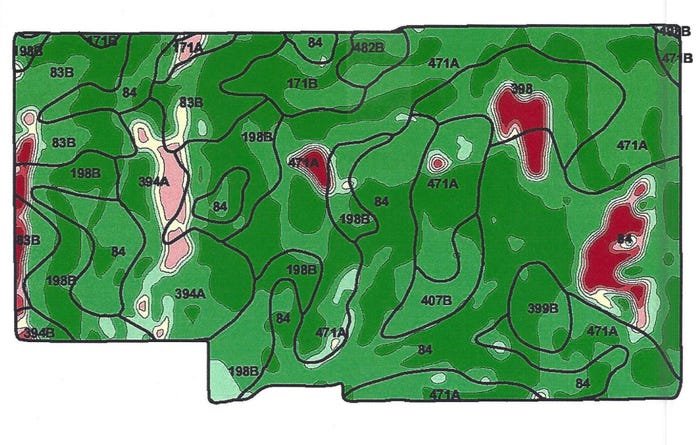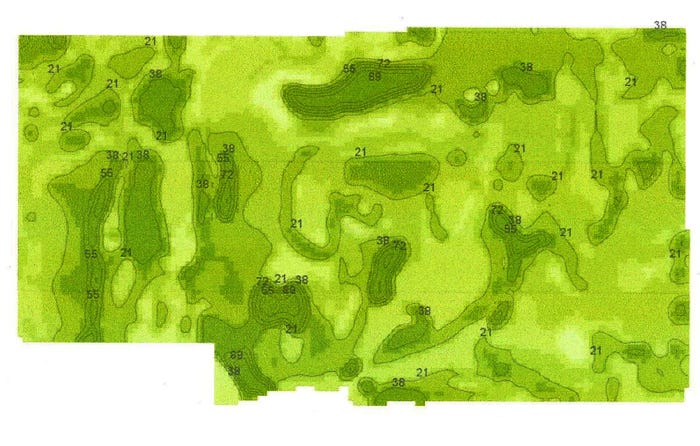September 8, 2017

THINK Different.
Brandon Reis wants to create smaller, more accurate zones from soil data to use as his base for variable rate farming. He “drilled down” to examine four soil characteristics that are limiting yields and plans to develop his own variable rate phosphorus and potassium spreading plan by overlaying new soils data onto 3 years of yield data.
------------
Brandon Reis thinks it’s best to work from a soil base to guide variable rate nutrient application and plant populations. But that doesn’t mean he’s going to continue to base variable rate decisions on his county soil survey, something he’s done since 2013.
“What I’ve seen is general shapes in fields from the soil survey, but the lines are off—something’s not quite right with the mapping,” the Lime Springs, Iowa farmer says. “The soil surveys that exist aren’t accurate enough for what we’re trying to do. We need better soils data.”

That’s why Reis worked with crop consultant Shannon Gomes earlier this year to literally drill down to a 4-foot depth across a 254-acre field to gather more comprehensive, accurate soils information. Gomes used the Trimble Soil Information System (SIS) to gather surface and subsurface soils information on a 10-meter resolution across the field. “We’ve been doing this by soil type and by the soil map lines, but now the zones will be smaller and I’ll create my own base map for the zones,” Reis says. “I’m modifying the base map by hand now, as I trust the data. You can have any size zone you want as long as you trust the data.”
Soil attributes correlate to yield
The SIS was used to analyze 56 different physical and chemical soil attributes, which Gomes then compared to three years of yield data. He selected four attributes that could be managed with variable rate technology that correlated strongest to crop yields. “The three soils attributes with the strongest tie to yields were surface potassium, surface pH, and surface compaction levels,” Reis says.
“Surface compaction has a lot to do with plant available water; we’ll compare that to yields again this fall. We’ll push populations where we have plant available water.” Reis says the deep probing and electromagnetic conductivity mapping from the SIS system gives him the information on soil bulk variability he needs for plant available water.
No need to rip
In a 237-acre northeast Iowa field, Gomes figures the SIS saved a farmer several thousand dollars as it identified compacted soils. “One of my customers was going to rip that whole field because he had compaction issues,” Gomes says. “But the SIS showed him only 16 of the 237 acres were compacted, and where those acres were. At $20 an acre, the cost of ripping would have been more than $4,000. In another field, the use of the deep core diver showed phosphorus was medium to hot, and a customer saved $2,000 by not applying phosphorus. “It pays to know your soil, and this system gives you as much accurate and detailed information as any I know,” says Gomes, a soil scientist.

Turn data into prescriptions
“We have an overwhelming amount of data. What we need to do is turn it into fertilizer and planting prescriptions,” Reis says. “Some of the data is interesting information that we won’t use. But I’ll use the P and K data to develop a variable rate potassium and phosphorus spreading plan. And we’ll use the pH map to more accurately apply lime—pH level is a key to many things for good crop growth,” he says. “We’ll use this year’s harvest to see how yields correlate to this soils data, and we’ll get smarter as we learn more about how to use the information.”
Reis says once you have the in-depth soils information, you have a quality decision base for years to come. It might not change his budget for fertilizers, but it will change how much he puts on the field in specific areas. “It’s going to be more targeted to where it will do the most good,” Reis says. “The key is to increase the resolution of soil properties in order to be more accurate with P, K, pH and water holding capacity,” Reis says.

Future subsurface plans
He plans to look into such things as subsurface soil organic matter levels, and subsurface pH in the future. “We’ve given Brandon a lot of tools he can use to do more discovery,” Gomes says. “He’s drilled down into this more than any other farmer I know. He’ll still have to be his own researcher to some extent.”
Basic soil tests cost about $8.50/acre, Reis says. That’s included in the $30/acre cost of SIS—Reis paid less because he participated in a grant project Gomes received through NRCS.
Reis says if this kind of detailed soil information were available for every farm, it would be a much better basis for buying land than using CSR (crop suitability ratings). “I’d like to continue to analyze this whole farm, or use this system on another farm,” Reis says. He and his father Ronald rotate corn and soybeans, using no-till. They have 75% of their land under cover crops, and put hog manure on about a third of their acres each year.

Water and input decisions
Zeroing in on water availability for input decisions in variable rate farming aligns with Dr. Jerry Hatfield’s thinking. The USDA-ARS soil health expert from Ames, Iowa, says when it comes to yields, water availability and management trumps nitrogen and everything else. “If you can control water, good soils don’t matter as much. On the other hand, healthy soils do help manage water. It’s not how much rain you get in the gauge, it’s how much you get into your soil.”
Hatfield notes that more than half the crop insurance claims across the Midwest from 1989 to 2013 were due to excess moisture or drought. “Across the Midwest, we lose about 20% of our yield 80% of the time due to short term stress, when we don’t have full transpiration of water. Doubling organic matter will double infiltration and double the amount of water that can be maintained in the profile.”
About the Author(s)
You May Also Like




